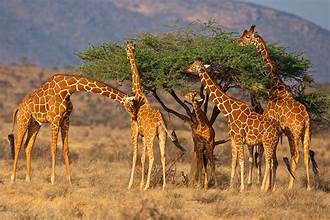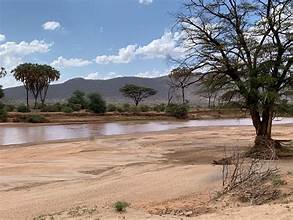Samburu National Park
Samburu National Park, a hidden gem in northern Kenya, offers an extraordinary safari experience with its unique landscapes, rich wildlife, and vibrant cultural heritage. Established in 1962, this park covers approximately 165 square kilometers and is along the banks of the Ewaso Ng’iro River. The park is named after the Samburu people, who have lived harmoniously with the wildlife for centuries. Samburu National Park is renowned for its distinctive arid ecosystem, which contrasts sharply with the lush greenery of the riverine forest. This park is a must-visit for those seeking an off-the-beaten-path adventure, offering a glimpse into Kenya’s wild and untouched beauty.

Overview
Samburu National Park is in the Rift Valley Province of northern Kenya, 350 kilometers north of Nairobi. The park’s terrain is rugged hills, open savannahs, and dense riverine forests along the Ewaso Ng’iro River. The river is the major component of the park, providing a crucial water source for the region’s diverse wildlife. Samburu is part of a larger ecosystem that includes Buffalo Springs and Shaba National Reserves, collectively known as the Samburu Complex. The park is home to several unique and endangered species, often called the “Samburu Special Five”: the reticulated giraffe, Grevy’s zebra, Somali ostrich, gerenuk, and Beisa oryx. Visitors can explore the park through game drives, guided walks, and cultural tours, which offer an immersive experience in this remarkable wilderness.

Wildlife in Samburu National Park
Samburu National Park is a haven for wildlife enthusiasts, offering an exceptional opportunity to observe rare and endangered species in their natural habitat. The park is known for its “Samburu Special Five,” which includes the reticulated giraffe, Grevy’s zebra, Somali ostrich, gerenuk, and Beisa oryx. These species are unique to the arid regions of northern Kenya and are not commonly found in other national parks. In addition to these special species, Samburu is home to other wildlife, including elephants, lions, leopards, cheetahs, buffalos, and hippos. The park’s riverine forests and savannahs support diverse birdlife, with over 450 bird species recorded, including the martial eagle, vulturine guinea fowl, and the pygmy falcon. The Ewaso Ng’iro River attracts a range of aquatic life, making it a prime spot for hippo and crocodile sightings.

Scenic Highlights
Samburu National Park is not only rich in wildlife but also boasts several scenic highlights that enhance the safari experience.
- Ewaso Ng’iro River: This river is a major part of the park, providing water for wildlife and vegetation. The river’s banks are lush, which creates a big contrast with the arid surroundings. The river is an excellent spot for game viewing and bird-watching.
- Luggard’s Falls: Named after Frederick Lugard, a British explorer, these falls are a series of rapids and small waterfalls along the Ewaso Ng’iro River. The falls are surrounded by smooth, sculpted rocks, making it a picturesque spot for photography.
- Koitelel Hill: This hill offers panoramic views of the park and the surrounding landscapes. It is an ideal spot for hiking and photography, providing a vantage point to observe wildlife and the park’s unique terrain.
- Samburu Cultural Village: Visit a traditional Samburu village to learn about the customs, traditions, and lifestyle of the Samburu people. These cultural visits offer a deeper understanding of the community’s close relationship with the environment.
Activities
Samburu National Park offers a range of activities that cater to different interests and provide unique ways to experience the park:
- Game Drives: The park’s extensive network of roads and tracks allows for excellent game viewing opportunities. Early morning and late afternoon game drives are the best times to see wildlife, as animals are most active during these periods.
- Guided Nature Walks: Explore the park on foot with experienced guides who provide insights into the park’s flora, fauna, and geology. Walking safaris offers a more intimate and immersive experience.
- Bird Watching: With over 450 bird species, Samburu is a bird-watcher’s paradise. Bring binoculars and a bird guidebook to identify and appreciate the park’s avian diversity.
- Cultural Visits: Engage with the local Samburu community and learn about their traditional lifestyles, customs, and crafts. These visits provide insights into the Samburu people’s close relationship with the natural environment.
Conservation Efforts
Samburu National Park plays a crucial role in wildlife conservation in Kenya. The Kenya Wildlife Service (KWS) manages the park and implements measures to protect its diverse species and habitats. Anti-poaching efforts have been essential in reducing illegal activities and ensuring the safety of the park’s wildlife, particularly elephants and the endangered Grevy’s zebra. Habitat restoration projects aim to restore degraded areas and promote biodiversity, ensuring the park’s ecosystems remain healthy and resilient. Community-based conservation programs involve local communities in sustainable practices, promoting coexistence and reducing human-wildlife conflict. These efforts are vital in preserving Samburu’s unique natural heritage for future generations.
Visitor Experience
Samburu National Park offers a variety of experiences that allow visitors to immerse themselves in its natural beauty and wildlife fully. Game drives provide the excitement of spotting animals in their natural habitat, while guided nature walks offer a closer look at the park’s flora and fauna. Bird-watching tours are perfect for those interested in the park’s avian diversity. For a more relaxed experience, enjoy a picnic by the Ewaso Ng’iro River or take in the views from Koitelel Hill. The park’s lodges and camps provide comfortable accommodations with modern amenities, ensuring a pleasant stay. Many lodges also offer guided tours, educational programs, and cultural visits to enhance the visitor experience.
Accessibility and Amenities
Samburu National Park is accessible by road and air. The park is approximately 6 hours from Nairobi, with the main entrance near Archer’s Post. Visitors can also fly into the park, with scheduled flights landing at the Samburu and Buffalo Springs airstrips. Once inside the park, a range of accommodations is available, from luxury lodges and tented camps to budget-friendly campsites. These accommodations offer various amenities, including guided game drives, nature walks, and bird-watching tours. Visitor centers provide valuable information about the park’s wildlife, conservation efforts, and activities. The park’s infrastructure ensures a comfortable and enriching experience for all visitors.

Best Time to Visit
The best time to visit Samburu National Park is during the dry seasons, from June to October and January to February. These periods offer the best weather for game viewing, as animals gather around water sources and are more easily spotted. The dry seasons also provide excellent conditions for bird-watching and photography. While the wet seasons, from March to May and November to December, bring lush vegetation and vibrant landscapes, some roads may become challenging to navigate. However, the wet seasons offer a quieter experience with fewer visitors and unique opportunities for photography.

Accommodation at Samburu National Park
Samburu National Park offers a range of accommodation options to suit various preferences and budgets. For luxury travelers, Samburu Intrepids Tented Camp features spacious tents with en-suite bathrooms and stunning river views. Samburu Sopa Lodge provides comfortable chalets surrounded by acacia trees, a swimming pool, and guided nature walks. Budget travelers can opt for Samburu Riverside Camp, which offers basic accommodations with shared facilities. Public campsites within the park also allow for a more adventurous experience, letting visitors immerse themselves in nature. No matter your choice, staying at Samburu ensures a memorable wildlife experience.
Practical tips for visitors
To make the most of your visit to Samburu National Park, consider the following tips:
- Dress Comfortably: Wear light, breathable clothing and comfortable footwear. Bring a hat, sunglasses, and sunscreen to protect against the sun.
- Carry Essentials: Pack water, snacks, binoculars, and a camera with extra batteries and memory cards.
- Respect Wildlife: Keep a safe distance from animals and never feed them. Follow the park’s rules and guidelines to ensure your safety and the well-being of the wildlife.
- Plan Ahead: Check the park’s opening hours and entry fees. Book guided tours or accommodations in advance, especially during peak seasons.
Conclusion
Samburu National Park is a jewel in Kenya’s natural heritage, offering an unparalleled safari experience. Its unique landscapes, abundant wildlife, and vibrant cultural heritage make it a must-visit destination for nature enthusiasts and adventurers. Whether exploring the park’s rugged terrain, observing the rare “Samburu Special Five,” or engaging with the local Samburu community, Samburu promises an unforgettable journey into the wild. By visiting, you promote the conservation of this unique ecosystem. Pack your bags, prepare for adventure, and embark on a safari to discover the wonders of Samburu National Park.
